One of the most imaginative prose writers of the 19th century, George Borrow was born on the outskirts of East Dereham in 1803, the son of an army captain, who bewitched a local girl while recruiting in the town. Educated at Norwich Grammar School, Borrow later took to the road. He could speak 20 languages, with his travels providing material for his best books The Bible in Spain, Lavengro and Romany Rye. Borrow eventually retired to the Norfolk Broads, where he died alone in 1881.
A print and text about Sir Henry Rider Haggard.
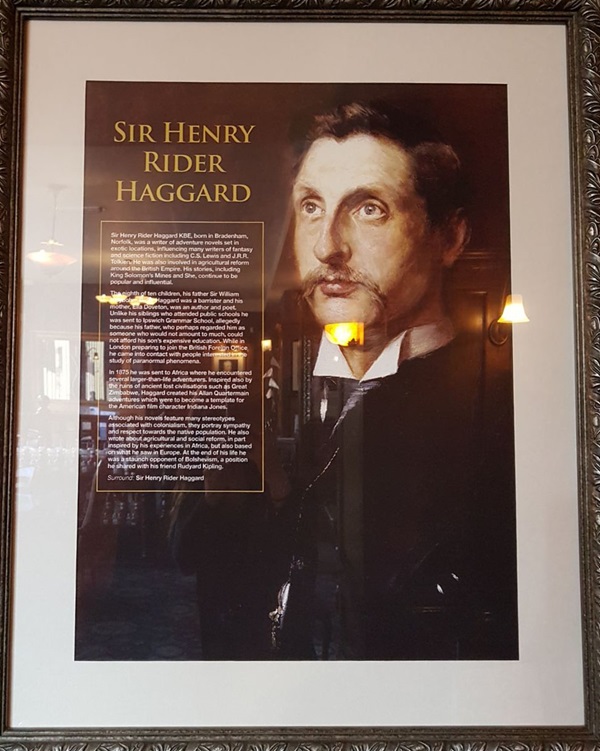
The text reads: Sir Henry Rider Haggard KBE, born in Bradenham, Norfolk, was a writer of adventure novels set in exotic locations, influencing many writers of fantasy and science fiction including CS Lewis and JRR Tolkien. He was also involved in agricultural reform around the British Empire. His stories, including King Solomon’s Mines and She, continue to be popular and influential.
The eighth of ten children, his father Sir William Meybohm Rider Haggard was a barrister and his mother, Ella Doveton, was an author and poet. Unlike, his siblings who attended public schools he was sent to Ipswich Grammar School, allegedly because his father, who perhaps regarded him as someone who would not amount to much, could not afford his son’s expensive education. While in London preparing to join the British Foreign Office he came into contact with people interested in the study of paranormal phenomena.
In 1875 he was sent to Africa where he encountered several larger than life adventures. Inspired also by the ruins of ancient lost civilisations such as Great Zimbabwe, Haggard created his Allan Quartermain adventures which were to become a template for the American film character Indiana Jones.
Although his novels feature many stereotypes associated with colonialism, they portray sympathy and respect towards the native population. He also wrote about agricultural and social reform, in part inspired by his experience in Africa, but also based on what he saw in Europe. At the end of his life he was a staunch opponent of Bolshevism, a position he shared with his friend Rudyard Kipling.
Surround: Sir Henry Rider Haggard.
A print and text about Thomas Paine.
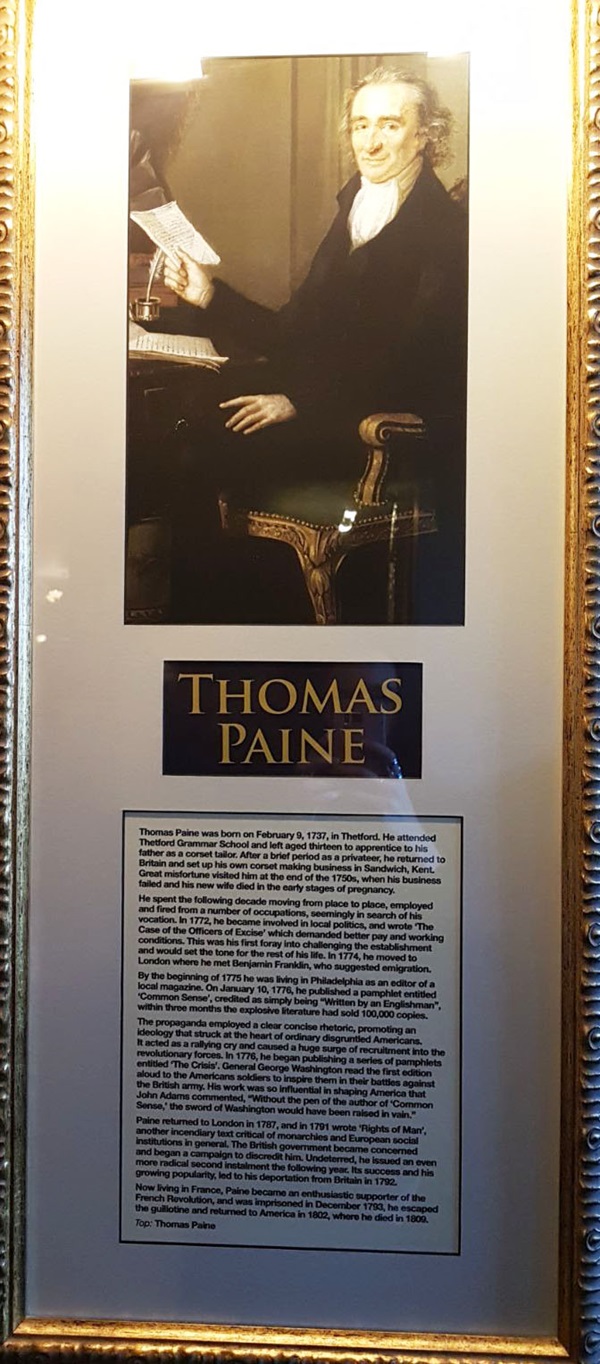
The text reads: Thomas Paine was born on February 9, 1737, in Thetford. He attended Thetford Grammar School and left aged thirteen to apprentice to his father as a corset tailor. After a brief period as a privateer, he returned to Britain and set up his own corset making business in Sandwich, Kent. Great misfortune visited him at the end of the 1750s, when his business failed and his new wife died in the early stages of pregnancy.
He spent the following decade moving from place to place, employed and fired from a number of occupations, seemingly in search of his vocation. In 1772, he became involved in local politics, and wrote The Case of the Officers of Excise which demanded better pay and working conditions. This was his first foray into challenging the establishment and would set the tone for the rest of his life. In 1774, he moved to London where he met Benjamin Franklin, who suggested emigration.
By the beginning of 1775 he was living in Philadelphia as an editor of a local magazine. On January 10, 1776, he published a pamphlet entitled Common Sense, credited as simply being “Written by an Englishman”, within three months the explosive literature had sold 100,000 copies.
The propaganda employed a clear concise rhetoric, prompting an ideology that struck at the heart of ordinary disgruntled Americans. It acted as a rallying cry and caused a huge surge of recruitment into the revolutionary forces. In 1776, he began publishing a series of pamphlets entitled The Crisis. General George Washington read the first edition aloud to the American soldiers to inspire them in their battles against the British army. His work was so influential in shaping America that John Adams commented, “Without the pen of the author of Common Sense, the sword of Washington would have been raised in vain”.
Paine returned to London in 1787, and in 1791 wrote Rights of Man another incendiary text critical of monarchies and European social institutions in general. The British government became concerned and began a campaign to discredit him. Undeterred, he issued an even more radical second instalment the following year. Its success and his growing popularity, led to his deportation from Britain in 1792.
Now living in France, Paine became an enthusiastic supporter of the French Revolution, and was imprisoned in December 1793. He escaped the guillotine and returned to America in 1802, where he died in 1809.
Top: Thomas Paine.
A photograph and text about Saint Withburga’s Well.
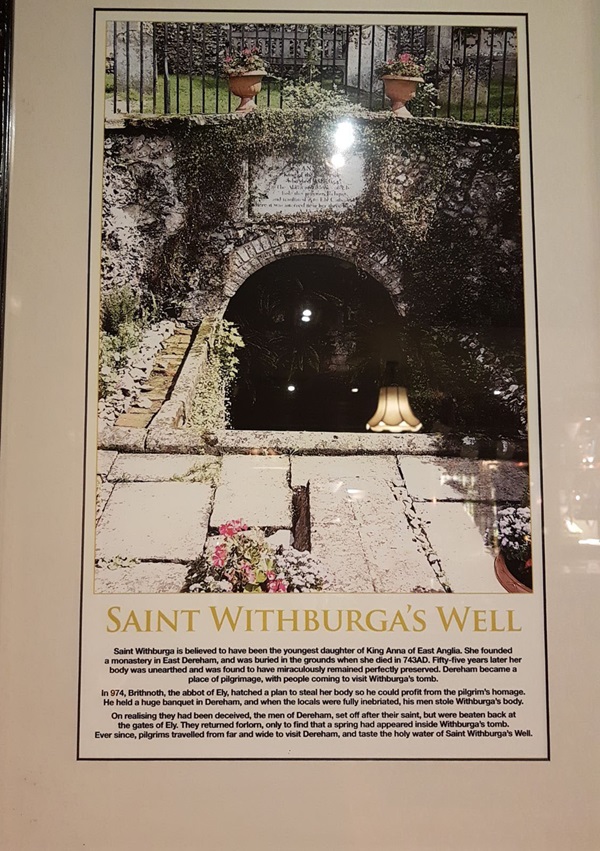
The text reads: Saint Withburga is believed to have been the youngest daughter of King Anna of East Anglia. She founded a monastery in East Dereham, and was buried in the grounds when she died in 743AD. Fifty five years later her body was unearthed and was found to have miraculously remained perfectly preserved. Dereham became a place of pilgrimage, with people coming to visit Withburga’s tomb.
In 974, Brithnoth, the abbot of Ely, hatched a plan to steal her body so he could profit from the pilgrim’s homage. He held a huge banquet in Dereham, and when the locals were fully inebriated, his men stole Withburga’s body.
On realising they had been deceived, the men of Dereham, set off after their saint, but were beaten back at the gates of Ely. They returned forlorn, only to find that a spring had appeared inside Withburga’s tomb. Ever since, pilgrims travelled from far and wide to visit Dereham, and taste the holy water of Saint Withburga’s Well.
An illustration and text about William Hoste.
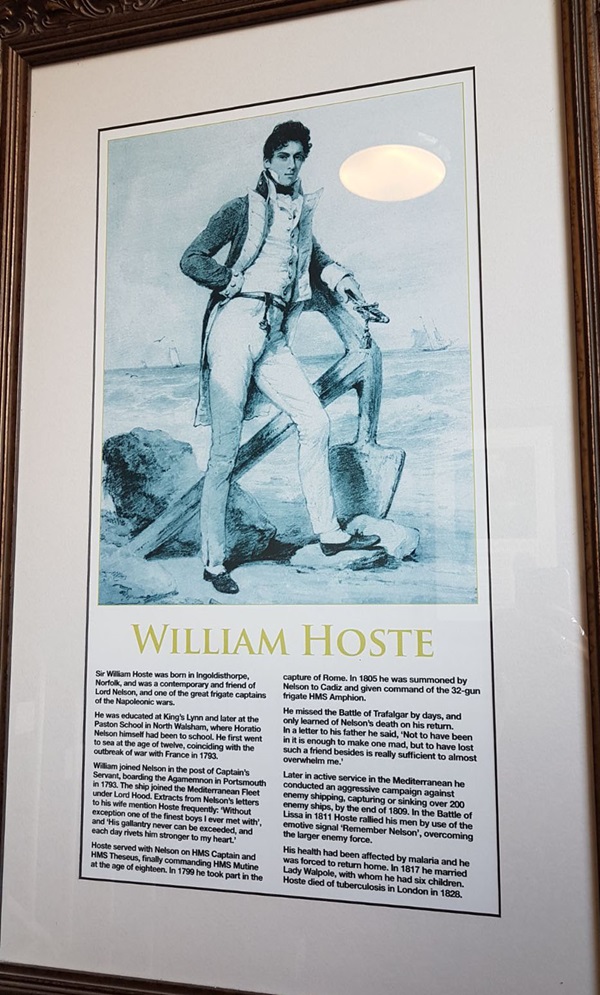
The text reads: Sir William Hoste was born in Ingoldisthorpe, Norfolk, and was a contemporary and friend of Lord Nelson, and one of the great frigate captains of the Napoleonic wars.
He was educated at King’s Lynn and later at the Paston School in North Walsham, where Horatio Nelson himself had been to school. He first went to sea at the age of twelve, coinciding with the outbreak of war with France in 1793.
William joined Nelson in the post of captain’s servant, boarding the Agamemnon in Portsmouth in 1793. The ship joined the Mediterranean fleet under Lord Hood. Extracts from Nelson’s letters to his wife mention Hoste frequently: ‘Without exception one of the finest boys I ever met with’, and ‘His gallantry never can be exceeded, and each day rivets him stronger to my heart’.
Hoste served with Nelson on HMS Captain and HMS Thesus, finally commanding HMS Mutine at the age of eighteen. In 1799 he took part in the capture of Rome. In 1805 he was summoned by Nelson to Cadiz and given command to the 32-gun frigate HMS Amphion.
He missed the Battle of Trafalgar by days, and only learned Nelson’s death on his return. In a letter to his father he said, ‘Not to have been in it is enough to make one mad, but to have lost such a friend besides is really sufficient to almost overwhelm me.’
Later in active service in the Mediterranean he conducted an aggressive campaign against enemy shipping, capturing or sinking over 200 enemy ships, by the end of 1809. In the Battle of Lissa in 1811 Hoste rallied his men by use of the emotive signal ‘Remember Nelson’, overcoming the larger enemy force.
His health had been affected by malaria and he was forced to return home. In 1817 he married Lady Walpole, with whom he had six children. Hoste died of tuberculosis in London in 1828
A print and text about Sir Robert Walpole.
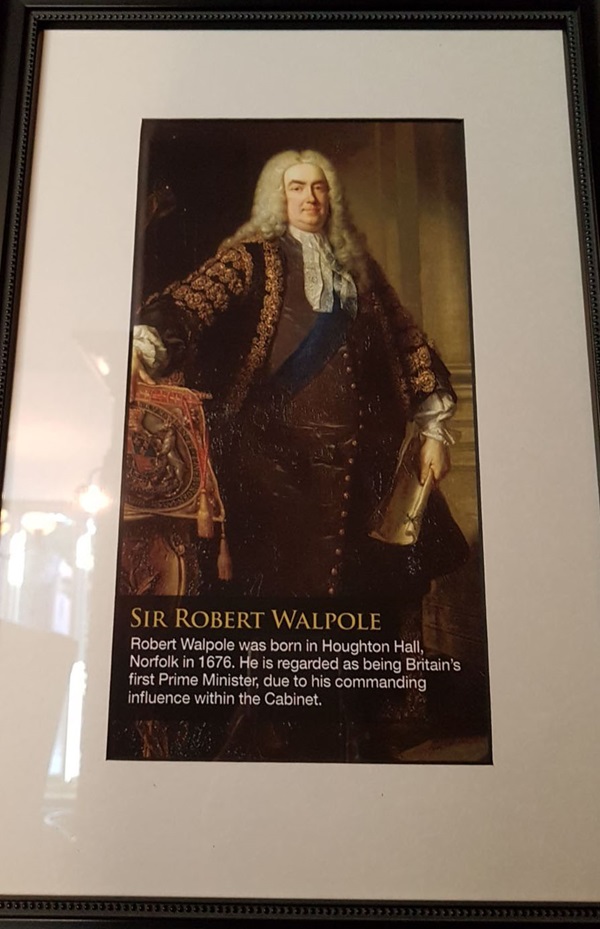
The text reads: Robert Walpole was born in Houghton Hall, Norfolk in 1676. He is regarded as being Britain’s first prime minister, due to his commanding influence within the cabinet.
Photographs and text about Wymondham Abbey.
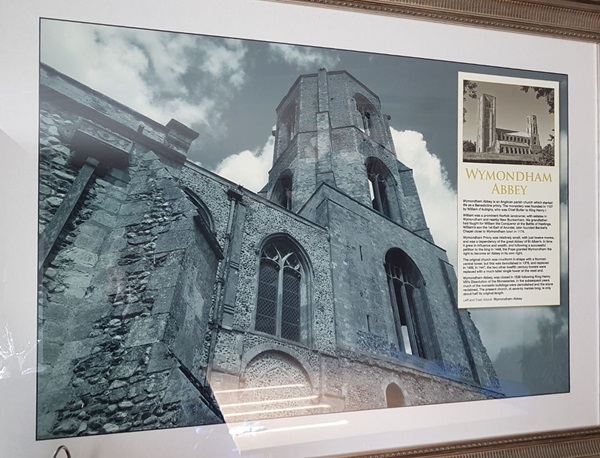
The text reads: Wymondham Abbey is an Anglican parish church which started life as a Benedictine priory. The monastery was founded in 1107 by William d’Aubigny, who was chief butler to King Henry I.
William was a prominent Norfolk landowner, with estates in Wymondham and nearby New Buckenham. His grandfather had fought for William the Conqueror at the Battle of Hastings. William’s son the 1st Earl of Arundel, later founded Beckets Chapel close to Wymondham town in 1174.
Wymondham Priory was relatively small, with just twelve monks, and was a dependency of the great Abbey of St Alban’s. In time it grew in influence and wealth, and following a successful petition to the king in 1448, the Pope granted Wymondham the right to become an abbey in its own right.
The original church was cruciform in shape with a Norman central tower, but this was demolished in 1376, and replaced in 1409. In 1447, the two other twelfth century towers were replaced with a much taller single tower at the west end.
Wymondham Abbey was closed in 1538 following King Henry VIII’s Dissolution of Monasteries. In the subsequent years much of the monastic buildings were demolished and the stone reclaimed. The present church, at seventy metres long, is only about half its original length.
Left and inset above: Wymondham Abbey.
A print and text about William Hyde Wollaston.
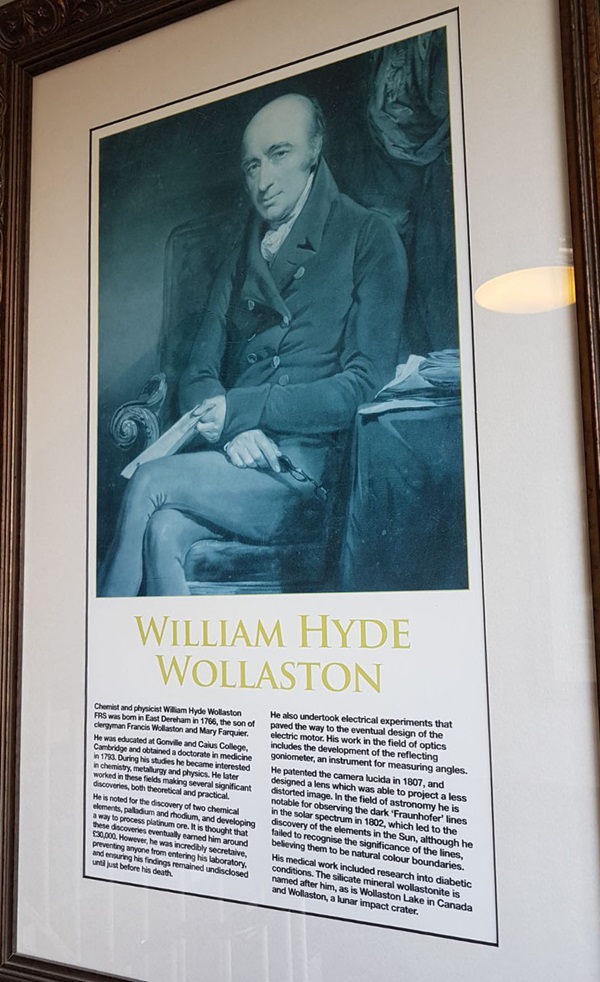
The text reads: Chemist and physicist William Hyde Wollaston FRS was born in East Dereham in 1766, the son of clergyman Francis Wollaston and Mary Farquier.
He was educated at Gonville and Caius College, Cambridge and obtained a doctorate in medicine in 1793. During his studies he became interested in chemistry, metallurgy and physics. He later worked in these fields making several significant discoveries, both theoretical and practical.
He is noted for the discovery of two chemical elements, palladium and rhodium, and developing a way to process platinum ore. It is thought that these discoveries eventually earned him around £30,000. However, he was incredibly secretive, preventing anyone from entering his laboratory, and ensuring his findings remained undisclosed until just before his death.
He also undertook electrical experiments that paved the way to the eventual design of the electric motor. His work in the field of optics includes the development of the reflecting goniometer, an instrument for measuring angles.
He patented the camera lucida in 1807, and designed a lens which was able to project a less distorted image. In the field of astronomy he is notable for observing the dark Fraunhofer lines in the spectrum in 1802, which led to the discovery of the elements in the sun, although he failed to recognise the significance of the lines, believing them to be natural colour boundaries.
His medical work included research into diabetic conditions. The silicate mineral wollastonite is named after him, as is Wollaston Lake in Canada and Wollaston, a lunar impact crater.
A print and text about James Woodforde.

The text reads: James Woodforde was born in Somerset on 27 June 1740, his father was the Rector of Ansford and Vicar of Castle Cary. He attended Winchester College, and Oxford University, and after taking his degree, returned to Somerset where he held various curacies. In 1774, he took up residence at Weston Longville in Norfolk, where he lived with his niece, Nancy, until he died in January 1803.
The clergyman lived a fairly quiet and unremarkable life, however, he kept a meticulous diary for nearly 45 years. Beginning on the 21 May 1763, his journal provides a unique insight into the life in rural 18th century England. He was very fond of Norwich, describing it “the fairest city in England by far” and always enjoyed a trip to the “sweet beach” at Yarmouth.
The Diary of a Country Person was published in five edited volumes by John Beresford during the 1920s, and proved very successful, with writers Virginia Woolf and Siegfried Sassoon, counted amongst its eager followers.
A photograph of Aldiss Hosier Outfitter.
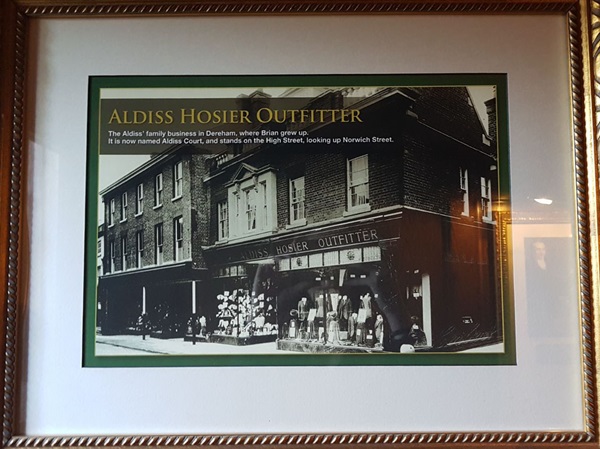
The Aldiss’ family business in Dereham, where Brian grew up. It is now named Aldiss Court, and stands on the High Street, looking up Norwich Street.
Prints and text about Sir Edward Coke.
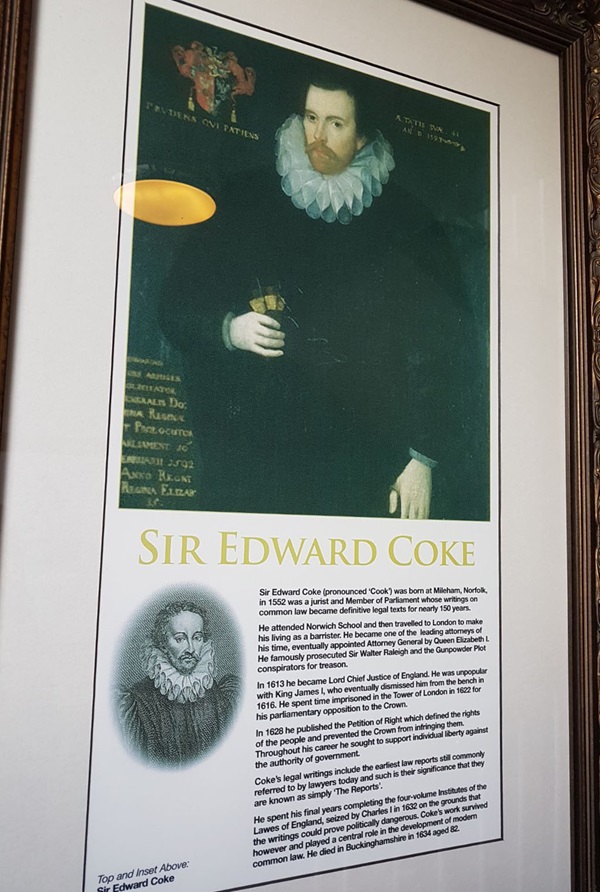
The text reads: Sir Edward Coke (pronounced Cook) was born at Mileham, Norfolk, in 1552 was a jurist and MP whose writings on common law became definitive legal texts for nearly 150 years.
He attended Norwich School and then travelled to London to make his living as a barrister. He became one of the leading attorneys of his time, eventually appointed Attorney General by Queen Elizabeth I. He famously prosecuted Sir Walter Raleigh and the Gunpowder Plot conspirators for treason.
In 1613 he became Lord Chief Justice of England. He was unpopular with King James I, who eventually dismissed him from the bench in 1616. He spent time imprisoned in the Tower of London in 1622 for his parliamentary opposition of the Crown.
In 1628 he published the Petition of Right which defined the rights of the people and prevented the Crown from infringing them. Throughout his career he sought to support individual liberty against the authority of the government.
Coke’s legal writings include the earliest law reports still commonly referred to by lawyers today and such is there significance that they are known as simply The Reports.
He spent his final years completing the four-volume institutes of the Lawes of England, seized by Charles I in 1632 on the grounds that the writings could prove politically dangerous. Coke’s work survived however and played a central role in the development of modern common law. He died in Buckinghamshire in 1634 aged 82.
Top and insert above: Sir Edward Coke.
A print and text about Robert Rolfe, 1st Baron Cranworth.

The text reads: Robert Monsey Rolfe was born on 18 December 1790, in nearby Cranworth. Following the completion of his education at Trinity College, Cambridge, he was called to the bar in 1816. He was highly regarded as a judge, noted for his sound common sense, and of being free from the prejudices of his day. He was elected as an MP for Penryn and Fairmouth and served twice as Lord High Chancellor of Great Britain.
A photograph and text about Dereham Railway Station.
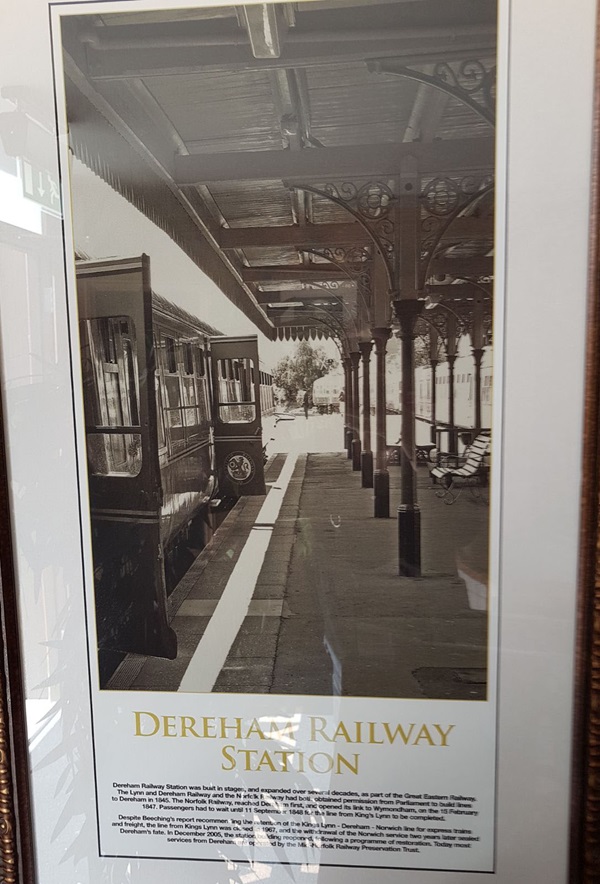
The text reads: Dereham Railway Station was built in stages, and expanded over several decades, as part of the Great Eastern Railway. The Lynn and Dereham Railway and the Norfolk Railway had both obtained permission from Parliament to build lines to Dereham in 1845. The Norfolk Railway reached Dereham first, and opened its link to Wymondham on the 15 February 1847. Passengers had to wait until 11 September 1848 for the line from King’s Lynn to be completed.
Despite Beeching’s report recommending the retention of the King’s Lynn – Dereham – Norwich line for express trains and freight, the line from King’s Lynn was closed in 1967, and the withdrawal of the Norwich services two years later sealed Dereham’s fate. In December 2005, the station building reopened, following a programme of restorations. Today most services from Dereham are operated by the Mid-Norfolk Railway Preservation Trust.
An illustration, photograph and text about Ellenor Fenn.
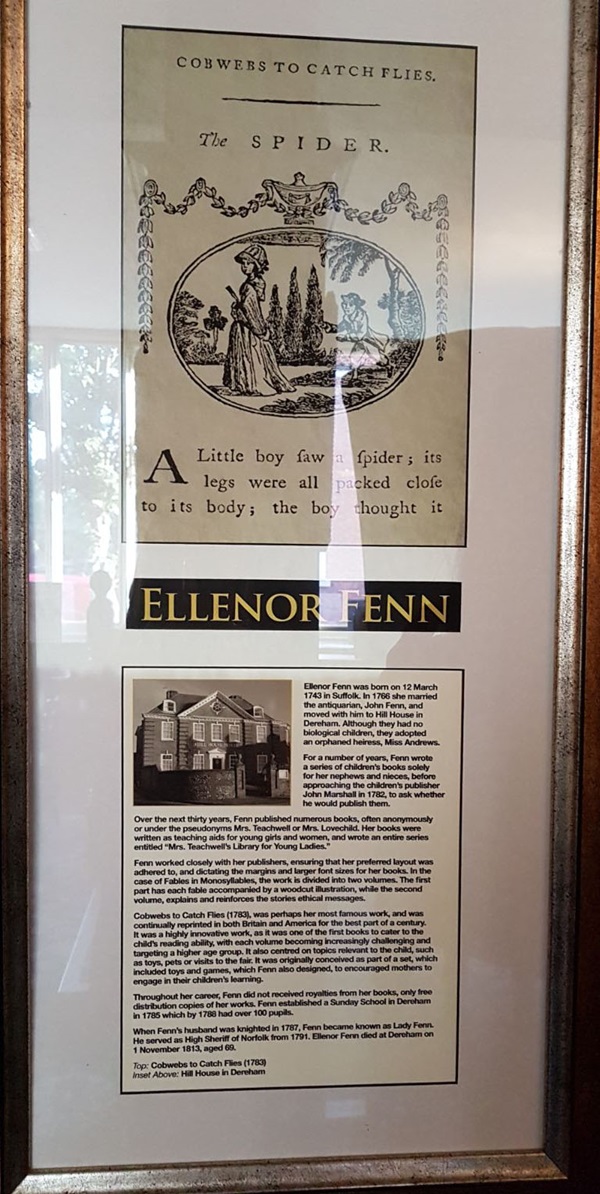
The text reads: Ellenor Fenn was born on 12 March 1743 in Suffolk. In 1766 she married the antiquarian, John Fenn, and moved with him to Hill House in Dereham. Although they had no biological children, they adopted an orphan heiress, Miss Andrews.
For a number of years, Fenn wrote a series of children’s books solely for her nephews and nieces, before approaching the children’s publisher John Marshall in 1782, to ask whether he would publish them.
Over the next thirty years, Fenn published numerous books, often anonymously or under the pseudonyms Mrs Teachwell or Mrs Lovechild. Her books were written as teaching aids for young girls and women, and wrote an entire series entitled Mrs Teachwell’s Library for Young Ladies.
Fenn worked closely with her publishers, ensuring that there preferred layout was adhered to, and dictating the margins and larger font sizes for her books. In the case of Fables in Monosyllables, the work is divided into two volumes. The first part has each fable accompanied by a woodcut illustration, while the second volume, explains and reinforces the stories ethical messages.
Cobwebs to Catch Flies (1783), was perhaps her most famous work, and was continually reprinted in both Britain and America for the best part of a century. It was a highly innovative work, as it was one of the first books to cater to the child’s reading ability, with each volume becoming increasingly challenging and targeting a higher age group. It also centred on topics relevant to the child, such as toys, pets or visits to the fair. It was originally conceived as part of a set, which included toys and games, which Fenn also designed, to encouraged mothers to engage in their children’s learning.
Throughout her career, Fenn did not receive royalties from her books, only free distribution copies of her works. Fenn established a Sunday School in Dereham in 1785 which by 1788 had over 100 pupils. When Fenn’s husband was knighted in 1787, Fenn became known as Lady Fenn. He served as High Sheriff of Norfolk from 1791. Ellenor Fenn died at Dereham on 1 November 1813, aged 69.
Top: Cobwebs to Catch Flies (1783)
Inset above: Hill House in Dereham.
A photograph of Frederick Duleep Singh.
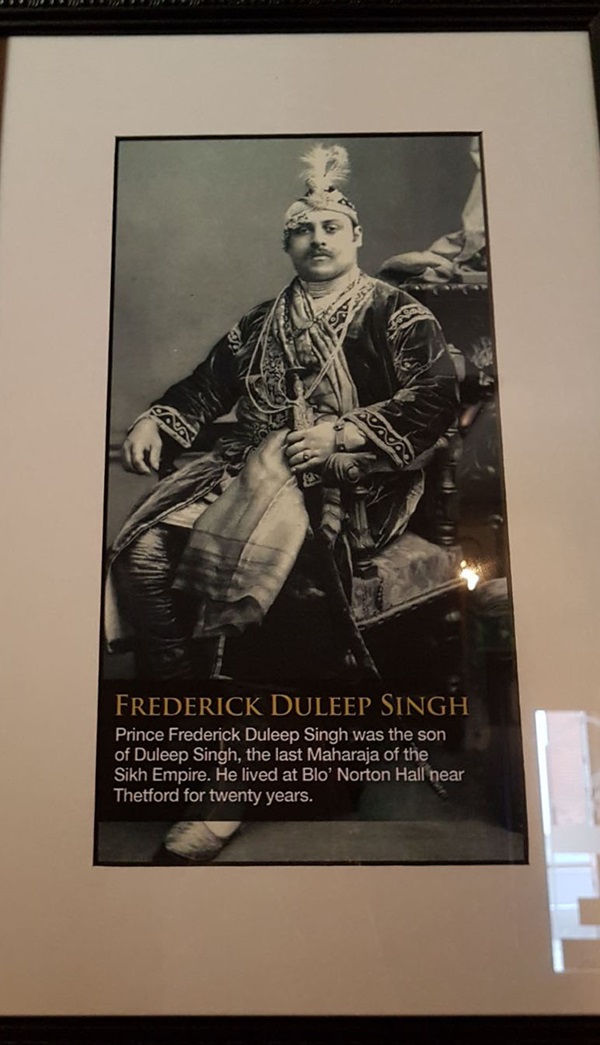
Prince Frederick Duleep Singh was the son of Duleep Singh, the last Maharaja of the Sikh Empire. He lived at Blo’ Norton Hall near Thetford for twenty years.
A photograph of an aerial view of Dereham.
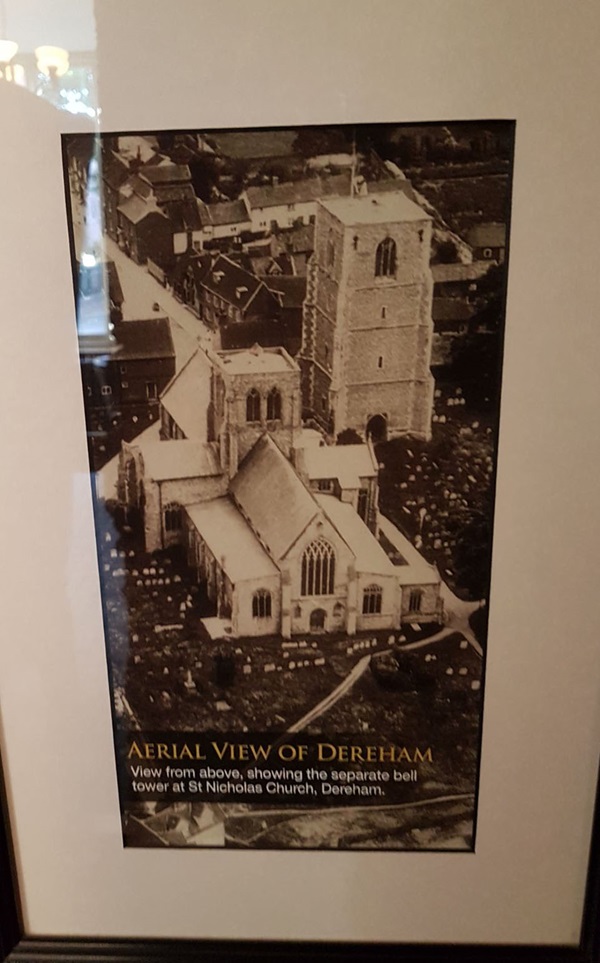
A view from above, showing the separate bell tower at St Nicholas Church, Dereham.
A photograph of the bell tower.
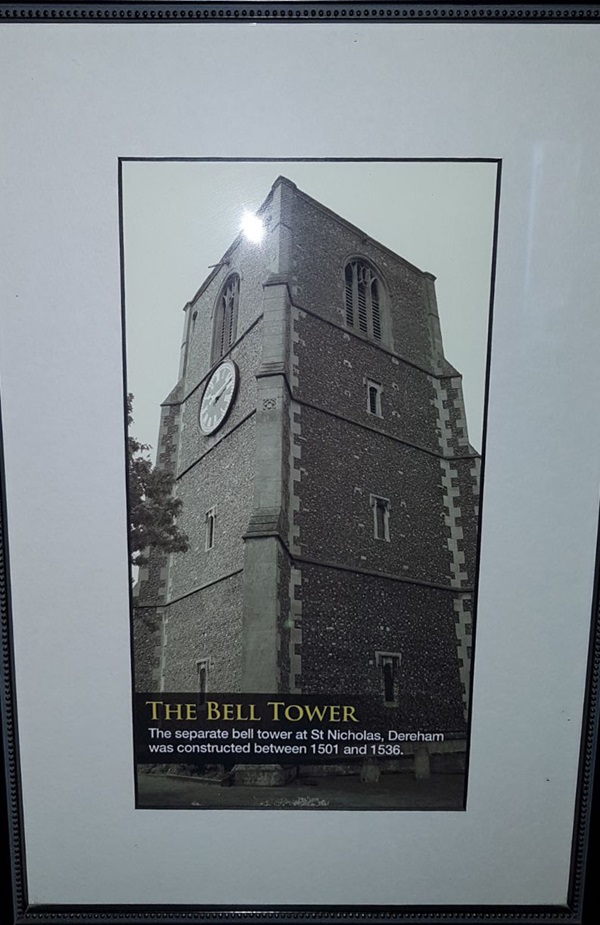
The separate bell tower at St Nicholas, Dereham was constructed between 1501 and 1536.
An oil painting entitled I First Saw The Light, by Claire Frances Smith.
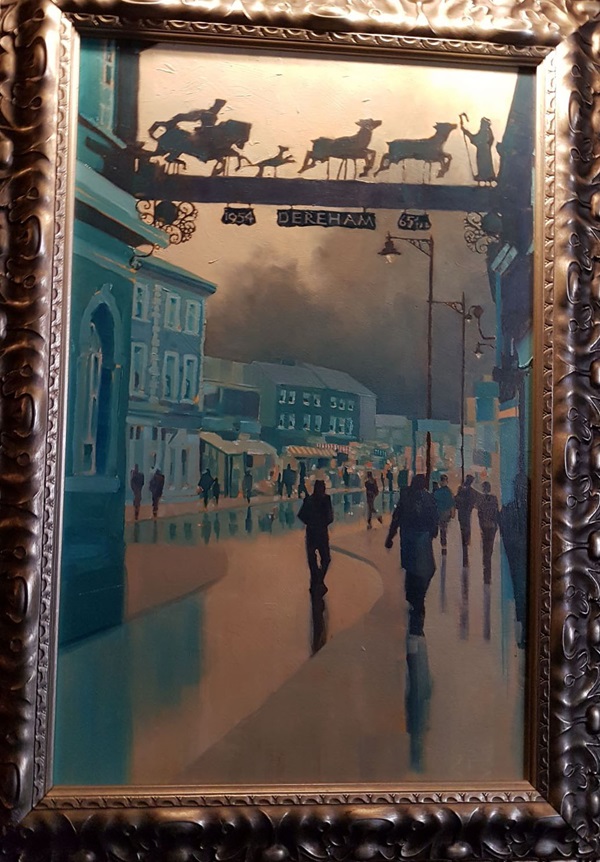
I was asked to paint the scene that came into my mind when reading the first line of George Borrow’s Lavengro – the book which preceded The Romany Rye.
‘On an evening of July, in the year 1800, at East Dereham, a beautiful little town in a certain district of East Anglia, I first saw the light’.
I have tried to capture a modern day scene which has meaning for the residents of today yet also linked to the thoughts of George Borrow.
A sculpture entitled George Borrow Mask, by Neal French.

The design for the George Borrow mask came from the only reliable portrait, but showing him when he lived in Dereham in his twenties. I modelled him in clay, moulded him in rubber and cast him in resin bronze.
External photograph of the building – main entrance.
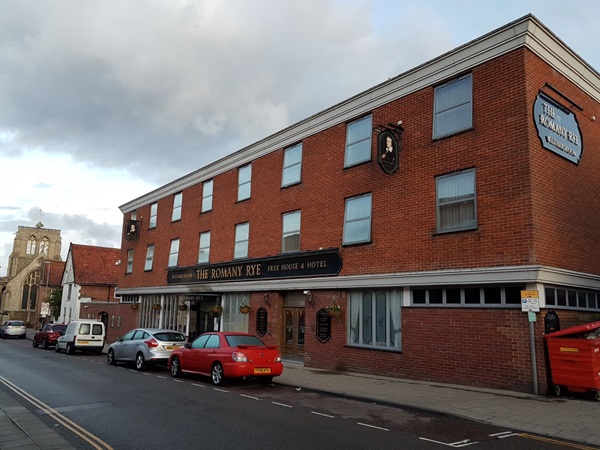
If you have information on the history of this pub, then we’d like you to share it with us. Please e-mail all information to: pubhistories@jdwetherspoon.co.uk